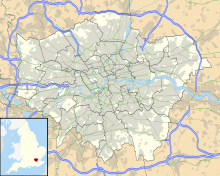
Coventry Transport Museum is a transport museum, located in Coventry city centre, England.

The Norton Motorcycle Company is a brand of motorcycles, originally based in Birmingham, England. For some years around 1990, the rights to use the name on motorcycles was owned by North American financiers. Later, a line of motorcycles was produced under Chief Executive Stuart Garner. Due to financial failure with large debts, in April 2020 administrators BDO agreed to sell certain aspects of Garner's business to Project 303 Bidco Limited, a new business established for the purpose with links to Indian motorcycle producer TVS Motor Company.
Triumph Engineering Co Ltd was a British motorcycle manufacturing company, based originally in Coventry and then in Meriden. A new company, Triumph Motorcycles Ltd based in Hinckley, gained the name rights after the end of the company in the 1980s and is now one of the world's major motorcycle manufacturers.

The Triumph Trident and BSA Rocket 3 was a technically advanced, high-performance roadster motorcycle made by Triumph Engineering and BSA from 1968 to 1975, and sold under both the Triumph and BSA marques. Alongside the Honda CB750, and later the Kawasaki triples, it brought a new level of sophistication to street motorcycles, marking the beginning of the superbike era. The Honda CB750 overshadowed the Trident to be remembered as the 'first superbike', in spite of the Triumph Trident actually debuting before the Honda by a few weeks.

Ariel Motorcycles was a British maker of bicycles and then motorcycles in Bournbrook, Birmingham. It was an innovator in British motorcycling, part of the Ariel marque. The company was sold to BSA in 1951 but the brand survived until 1967. Influential Ariel designers included Val Page and Edward Turner. The last motorcycle-type vehicle to carry the Ariel name was a short-lived three-wheel tilting moped in 1970.

Associated Motor Cycles (AMC) was a British motorcycle manufacturer founded by the Collier brothers as a parent company for the Matchless and AJS motorcycle companies. It later absorbed Francis-Barnett, James, and Norton before incorporation into Norton-Villiers. Henry Herbert Collier founded Matchless as a cycle company in 1878. His sons Henry (Harry) and Charles (Charlie) joined him and the name was changed to H. Collier & Sons.
Norton Villiers Triumph (NVT) was a British motorcycle manufacturer, formed by the British government to continue the UK motorcycling industry, but the company eventually failed.
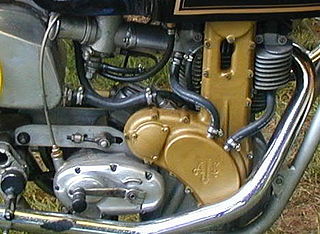
Pre-unit construction, also called separate construction, is a motorcycle engine architecture where the engine and gearbox are separate components with their own oil reservoirs, linked by a driving chain within a primary chaincase. Mounting plates are usually attached to the frame allowing for chain adjustment by gearbox fore-and-aft movement and via screw adjusters and elongated mounting holes. Even though Singer offered an integrated engine and gearbox in a single casing in 1911, it was not until the 1950s that technical advances meant it was possible to reliably construct engines with integral gearboxes in a single unit, known as unit construction.

Edward Turner was an English motorcycle designer. He was born in Camberwell in the London Borough of Southwark, on the day King Edward VII was proclaimed King. In 1915, Turner had his first ride on a motorcycle, a Light Tourist New Imperial.

The National Motorcycle Museum occupies an 8-acre (32,000 m2) site in Bickenhill, Solihull, England and holds the world's largest collection of British motorcycles. In addition to over 850 motorcycles, which cover a century of motorcycle manufacture, the museum has conference facilities. It is located close to the junction of the A45 and the M42, very close to Birmingham Airport.

The BSA Golden Flash, commonly referred to as the Gold Flash, was a 646 cc (39.4 cu in) air-cooled parallel twin motorcycle designed by Bert Hopwood and produced by Birmingham Small Arms Company (BSA) at Small Heath, Birmingham. The Golden Flash was the first model in the BSA A10 series. It was available in black and chrome; but it was the distinctive golden paint scheme that gave The Golden Flash its name. Production continued until 1963, when it was superseded by the BSA A65 Star.

The Triumph Legend 964cc and Legend 741cc are British motorcycles developed by Les Williams, the former Triumph racing manager.

The BSA Fury was a Birmingham Small Arms Company (BSA) prototype motorcycle made in 1970. Designed by Edward Turner but substantially redesigned by Bert Hopwood and Doug Hele, the Fury never went into commercial production due to the collapse of the BSA Group.
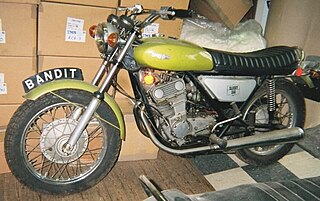
The Triumph Bandit was a British motorcycle manufactured as a prototype by Triumph in 1970. Originally designed by Edward Turner as his last project it was subsequently substantially modified at Triumph by a greatly critical Bert Hopwood and Doug Hele. Despite their work, the Bandit never went into commercial production, and only five have survived, making them very rare.
The British Motorcycle Charitable Trust (BMCT) is a Charitable Trust dedicated to promoting and supporting the preservation and restoration of British motorcycles. Established as a Registered Charity and a Company Limited by Guarantee in 1979, the Trust aims to protect and restore rare British motorcycles and provide access to the public through a network of museums and annual motorcycle heritage events. The Trust also provides support and resources to educational establishments, clubs and private individuals and maintains information on all aspects of British motorcycles.

The Triumph Tiger 80 is a British motorcycle first made by Triumph from 1937. There was also a 250cc Tiger 70 and a 500cc Tiger 90. Production of the Tiger ended with the outbreak of World War II and never resumed after the Triumph works at Priory Street in Coventry were completely destroyed during The Blitz in 1940 by heavy German bombing.
The BSA B50 was a single-cylinder 499 cc (30.5 cu in) ohv motorcycle, produced by BSA at their factory in Small Heath, Birmingham. The last of the big capacity unit-construction singles from the Birmingham Small Arms company, it had an alloy engine with a bore of 84 mm (3.3 in) and a stroke of 90 mm (3.5 in). As well as the road version, special models were produced for off-road competition use.
BSA motorcycles were made by the Birmingham Small Arms Company Limited (BSA), which was a major British industrial combine, a group of businesses manufacturing military and sporting firearms; bicycles; motorcycles; cars; buses and bodies; steel; iron castings; hand, power, and machine tools; coal cleaning and handling plants; sintered metals; and hard chrome process.
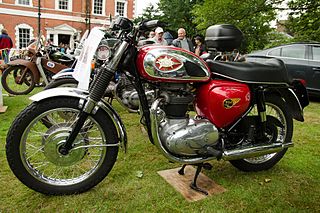
The BSA unit twins were a range of unit construction twin-cylinder motorcycles made by the Birmingham Small Arms Company (BSA) and aimed at the US market. A range of 500 cc (31 cu in), 650 cc (40 cu in) and 750 cc (46 cu in) twins were produced between 1962 and 1972, but they were really developments of the older pre-unit A7/A10 model range with less weight. The engines had a reputation for vibration, but acceleration was good for the time, to a top speed of 100 miles per hour (160 km/h).
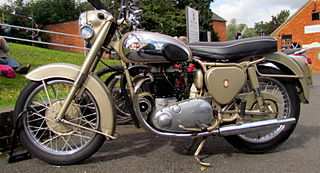
The BSA A10 series was a range of 646 cc (39.4 cu in) air-cooled parallel twin motorcycles designed by Bert Hopwood and produced by Birmingham Small Arms Company at Small Heath, Birmingham from 1950 to 1963. The series was succeeded by the A65 unit construction models.


